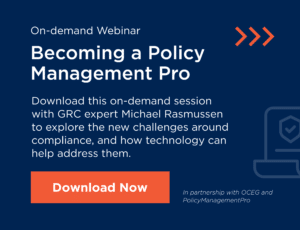 Policies, and in that context the management of policies, have become critical to define and guide culture and behavior in today’s distributed, dynamic, and disrupted business environment. Today’s organization can no longer take a haphazard approach to policies and the management thereof.
Policies, and in that context the management of policies, have become critical to define and guide culture and behavior in today’s distributed, dynamic, and disrupted business environment. Today’s organization can no longer take a haphazard approach to policies and the management thereof.
When an organization fails to establish strong policies, the organization quickly becomes something it never intended. Good policies define the organization’s governance posture, corporate culture, behavioral boundaries, and objectives.
Without the guidance provided by well-written and effectively managed policies, corporate culture may morph and take the organization down unintended paths. Policies are critical to managing risk, every policy is a risk document that aims to control behavioral-related risks.
Part of our Becoming a Policy Management Pro series
The benefits of properly implementing policies
Policies, done right, articulate and build the desired corporate culture and drive standards for individual and business conduct.
- Policies articulate the governance culture: Policies address more than how to meet legal requirements; they also drive the performance objectives of the organization. Without policies, the organization has not made clear what people or business units may or may not do in seeking to meet those objectives.
- Policies articulate the risk culture: Every organization takes risk — it is part of the business and sometimes helps to get the business where it wants to be. Without clearly written policies and ownership, however, risk governance will be ineffective and risk decisions will be made by each individual based on his or her personal appetite
- Policies articulate a culture of compliance: Policies define what is acceptable and unacceptable. Policies also establish the values, ethics, commitments, and social responsibility of the organization when it comes to matters of discretion. Policies that are enforced, provide an organization with a defensible position against the actions of rogue employees and demonstrate how the organization meets legal, regulatory, contractual, and other requirements.
Issuing well-crafted, and appropriately targeted policies is a necessary first step in clearly defining and communicating the organization’s boundaries, practices, and expectations. Policies are the vehicles that communicate and define values, goals, and objectives so that culture does not morph out of control. This enables the organization to embed culture into the action and behavior of processes, transactions, relationships, and individuals.
A strong embedded culture is driven by an effective policy management capability that provides consistency in behavior, reduces costs and inefficiencies, and supports growth and change management. This leads to higher employee engagement and achievement of objectives.
In teaching on policy management all over the world, I have found that organizations are looking to understand best practices and develop an organized structure for implementing it. As organizations move from different departments going in different directions with policies to a structured enterprise consistency in policy management, this has become even more critical.
A new resource for Policy Management
To address this challenge – and provide framework for what an effective policy management program looks like – I have worked with OCEG in developing www.PolicyManagementPro.com. The goal is to provide open-source resources that help define what an effective, efficient, and agile policy management program looks like. The goal is:
- Develop policy management professionals in their career by providing structured training on policy management framework and best practices. Whether you are in human resources, legal, corporate compliance, ethics, information technology, accounting, environmental, quality, or more, the content on PolicyManagementPro.com is aimed to provide consistency in policy management across the enterprise and its various departments and functions that issue policies.
- Provide the open-source Policy Management Capability Model as an effective framework to build a policy management strategy. This open-source (free) standard has been publicly vetted with other policy management professionals and provides a structure of essential practices to build a program at both the enterprise as well as department-levels.
- Certify policy management professionals by leveraging the training and Policy Management Capability Model to provide a certification credential that certifies individuals, as well as whole teams, on policy management. This allows them to stand out and demonstrate expertise and knowledge to the essential domain of policy management.
It’s time for an effective and vetted framework
Policies are necessary in organizations, and they can no longer be managed haphazardly. Too many organizations do not even have an index of what all the official policies are in the organization. This has fostered an environment that has been inundated with poorly written, out-of-date, and rogue policies that the organization never approved.
Policies that put a legal duty of care and liability on the organization and exposes them to more risks. It is time for organizations to ensure they have defined policy governance in their organization and PolicyManagementPro with the Policy Management Capability Model is the only source for a vetted open source standard and framework to deliver on it.
[bctt tweet=”It is time for organizations to ensure they have defined policy governance in their organization.” username=”Michael Rasmussen”]



